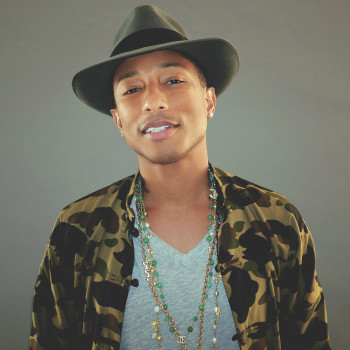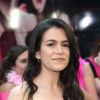Singer, rapper, rocker, songwriter, record producer, multi-instrumentalist, occasional fashion designer, hat enthusiast, and general pop star of the highest order Pharrell Williams must have a pretty big trophy cabinet at this point. While he didn’t pick up the Best Song Oscar for which he was nominated this month, he does already hold ten Grammys among his many other honors.
Pharrell released his new solo album “G I R L” this week, and in addition to upbeat roof-raisers and at least one song about an alien, it features his megasmash tune “Happy”… which, it turns out, he sees in a very unusual way — literally. He told Rico about that, but not before reflecting on the fact “Happy” is the third multi-million-selling #1 single on which he’s appeared in just the last year.

Pharrell Williams: Listen, even this interview, and having questions like this, I’m having to pinch myself, like, “Is this real? Are they talking to me?” Because I’ve always been the guy that’s been in the kitchen for that.
Rico Gagliano: Yeah — you produce big hits. You didn’t perform them.
Pharrell Williams: Yeah, I was sort of making the meal. I’ve never really been the host of the party. That’s why it’s just crazy.
Rico Gagliano: I can’t even imagine.
Something that caught our eyes: you have synesthesia. Which is a condition, in your case, that means you can actually see sound. For instance, as colors. My question is: what does that song “Happy” look like to you?
Pharrell Williams: Believe it or not, “Happy” has always been yellow and red for me. It’s weird.
Rico Gagliano: The yellow makes sense to me because it’s sunshiney, but what’s the red, do you think?
Pharrell Williams: The yellow part is the verses, and then the red… well, I could be wrong; it’s not red, it’s more like orange, but then it’s a little pink, a little rainbow-y, because of the minor chords or whatever. Those minor chords give me a more exotic set of colors. When you hear that “because I’m happyyy…” that part? Those harmonies, each one of those harmonies sort of has a color.
Rico Gagliano: Ohhh, so they’re sort of laying on top of each other, and creating a new, less primary color?
Pharrell Williams: Right. Whereas the verses are very triangle-y and yellow. And I know all of this sounds so crazy to people who are probably listening! But trust me when I tell you this, it’s not just me. There are so many musicians and so many artists who see music in colors.
Rico Gagliano: I did look at a list of musicians that have synesthesia and it’s pretty impressive. Duke Ellington is on there, Billy Joel…
Pharrell Williams: And even Stevie Wonder, who they say is blind — but he’s also a synesthete.
Did you know that for every musical note there is an equivalent of a color and a frequency?
Rico Gagliano: Really?
Pharrell Williams: Yeah. Like, C is red.
Rico Gagliano: How is the color assigned to the note?
Pharrell Williams: The simplest way to explain it is that the electromagnetic spectrum has everything from gamma rays to X-ray,s and there’s a small portion in there that we can see that’s also equivalent, mathematically, to hertz.
Rico Gagliano: Hertz — like wave frequency. And there’s some sort of correspondence between light and sound frequencies?
Pharrell Williams: Yeah. In fact, the way that the astronomers search for the stars is basically in sounds. They usually say that most of the stars are emitting Bs and Cs and As.
Rico Gagliano: B notes and C notes and A notes?
Pharrell Williams: Yeah.
Rico Gagliano: That would blow my mind if it turned out that every hit song that you ever had just happened to have exactly those notes in it.
Pharrell Williams: It would be like a specific star constellation? How rad would that be?!
Rico Gagliano: It would. And then you’d have the celestial key to writing hit songs over and over and over again.
Pharrell Williams: Yeah, but then I would owe God publishing.

After this interview aired… we mentioned that we’d be grateful if you all could help us understand Pharrell’s thoughts on the stars and sound. Astronomer David Fierroz, a research scientist with NYU’s Center for Cosmology and Particle Physics, obliged. (Thanks, David!)
Pharrell said “the way that the astronomers search for the stars is basically in sounds” and that is basically true. Like how our ears detect sound waves emanating from a ringing bell, telescopes detect electromagnetic waves (light) emanating from a star. The sound heard of a mallet dragged up a xylophone from low to high frequencies is analogous to watching a light show go “up” the colors of the rainbow from red, near the low frequency end that the human eye can see, to violet, on the high frequency end. If you were to say that the yellowish color of our sun is a middle C, then you could say that “most of the stars are emitting Bs and Cs and As” if you mean that most stars have a more reddish/lower frequency color than the sun, which is true.
It is important to note that this great analogy is just that, an analogy and not a physical connection. Sound waves and electromagnetic waves are waves equal but separate. They do not travel on the same medium so they do not interact with each other, even when they have the same exact frequency. Sound travels through particles at the speed of sound, while electromagnetic waves travels through the electromagnetic field at the speed of light. What is cool is that any oscillating disturbance that travels through space is a wave, so you can really let your imagination go wild with other possibilities. For example, when you do “the wave” at a stadium for a Pharrell concert, the medium here is humans and that too can be analogized to music notes and the colors of stars. Imagine that a stadium wave goes from low a frequency to a high frequency while maintaining the same speed, like the xylophone and rainbow examples. What you would see is the stadium wavelength go from say 40 people wide to 10 people wide. All happy I imagine.



Pingback: “Yeah, but then I would owe God publishing,” says Pharrell Williams, a synesthete | GoodMorningGloucester()